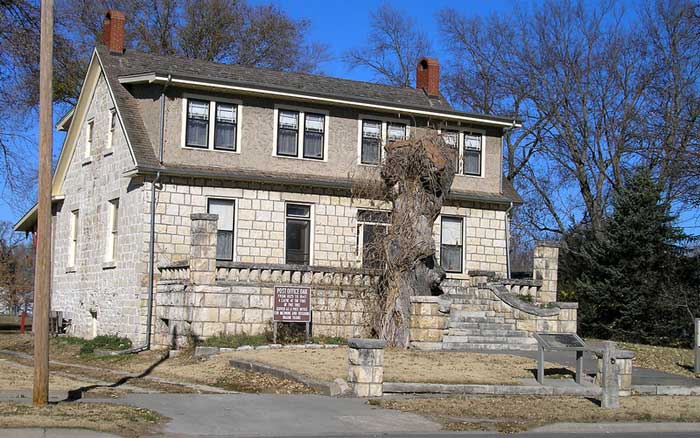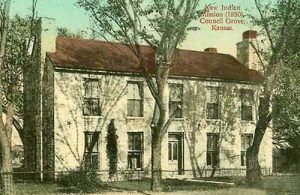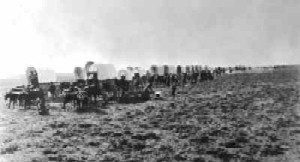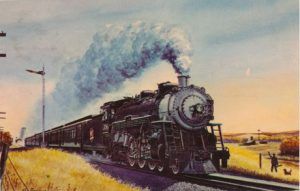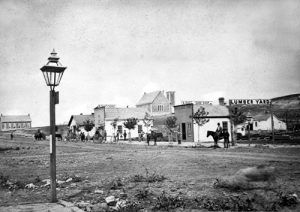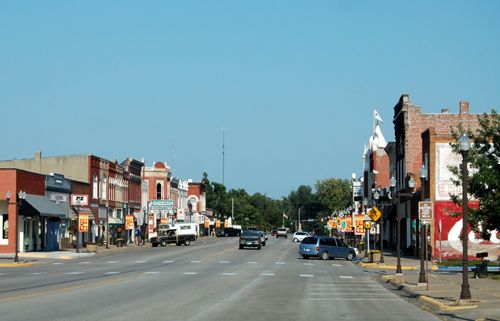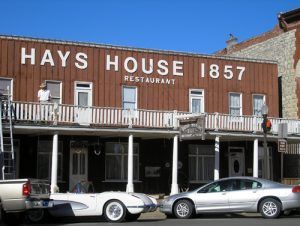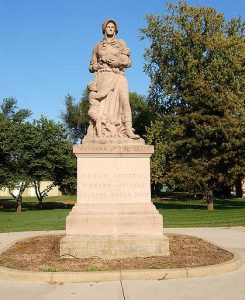Council Grove, Kansas – Supplying the Santa Fe Trail – Legends of America (original) (raw)
The county seat of Morris County and one of the most historic towns of Kansas, Council Grove is situated on the Neosho River in the eastern part of the county.
The place where Council Grove now stands was mentioned by travelers as early as 1820, and in 1825, a treaty was negotiated with the Osage Indians for a right-of-way for the Santa Fe Trail, a portion of which would later become the main street of Council Grove. The treaty between U.S. commissioners and the Osage Indian chiefs took place in “The Grove,” thereby providing the name of the place.
Long before a town ever developed, many who traveled along the Santa Fe Trail gathered their wagons together here, and moved westward in larger groups, as beyond the “Grove” the trail was often fraught with Indian attacks.
Council Grove Post Office Oak. The old oak tree has since been removed and replaced with a pole. By Kathy Alexander.
As early as 1825 and continuing for the next two decades, a large oak tree, dubbed “The Post Office Oak,” was utilized by passing caravans to leave messages for incoming travelers. These messages placed in a cache in the base of the tree, held various types of information, such as water, danger, or opportunities on the trail.
In the spring of 1846, the Kanza Indians signed a treaty with the government ceding their reservation land along the Kansas River near Topeka in exchange for a new but smaller reservation located along the upper valley of the Neosho River, in what is now Morris County. In April 1847, the 20-square-mile Kanza reservation was established near Council Grove, and the Indians were moved.
That same year, Seth M. Hays became the first settler in what would become the settlement of Council Grove. Here, he established a trading post for trading with the Indians. He also built the first house – a log cabin on the north side of the old Santa Fe Trail near the west bank of the Neosho River. The cabin served as both a store and a dwelling, which housed Mr. Hays, his adopted daughter, and a freed slave.
In 1848, Mitchell came to Council Grove as a government blacksmith, bringing with him his wife, who was the first white woman in Morris County.
Today, the Kaw Mission still stands in Council Grove, serving as a museum.
In 1849, the Methodist Episcopal Church began to build the Kaw Mission at Council Grove. It opened in 1850, and Thomas S. Huffaker was its first teacher, a position he held until 1854, when the school was closed. The Kaw Mission would later become the first school for the settlers’ children.
For the next several years, many other traders found their way to the area, and many put up trading establishments along the Santa Fe Trail. The traders did well for years, as Council Grove was the last trade point on the trail until travelers reached New Mexico.
From 1849 to 1854, it was a very prosperous period for Council Grove, and the reputation it had acquired as a trading post made it a point well known, at least to all those making a trip across the plains. By 1854 the men doing business in Council Grove were Seth M. Hays, the Choteau brothers, Columbia brothers, and Charles H. Withington; and these, with a few employees, and several men in the employ of the Government, constituted the entire settlement, not only of Council Grove but of Morris County.
In October 1854, Governor Andrew Reeder visited Council Grove intending to make it the territorial capital, but the land was at that time an Indian possession.
The first hotel in the town was built by M. Gilkey in 1856, on the south side of Main Street, directly opposite the log cabin built by Seth Hays in 1847. Baker and Sewell built the next home. The following year, Seth Hays also built the Hays House, which today is the oldest continuously operating restaurant west of the Mississippi River. The Last Chance Store was built the same year.
In 1858, the Legislature approved the incorporation of the Town Company of Council Grove, with the following men as officers — T.S. Huffaker, Christopher Columbia, Seth Hays, and Hiram Northrup. Soon the townsite was surveyed, and a settlement “officially” began. The first newspaper, called the Kansas Press was established in 1859 by S.N. Wood.
Wagon Train
Although the area had a considerable business from its earliest days, the town’s growth was relatively slow. Its business was derived chiefly, if not wholly, from the Indians and wagon trains traveling over the Santa Fe Trail. In 1860, there were but two stores in town, one operated by Seth Hays and the other by Malcolm Conn. At that time, the entire county had only about 770 residents. The terrible drought of 1860 left not only Morris County but all of Kansas wasted and desolate and diminished the county’s population even further.
In 1861, S.N. Wood sold the Kansas Press to A. I. Baker, who changed the newspaper’s name to the Council Grove Press. However, Baker ran the paper for only about a month before he suspended publication. In the meantime, the Civil War erupted. When Colonel S.N. Wood returned to Council Grove, he found that Missouri bushwhackers had killed A.I. Baker, and he resumed publication of the newspaper. Wood continued to manage the paper until 1865, when he sold it. The following year, it moved to another county.
In 1866, the town’s prosperity received another severe blow when the Stage Line Company moved to Junction City. The long wagon trains that previously formed at Council Grove now formed at Junction City and moved westward over the Smoky Hill Trail, cutting off much of the prosperous trade.
In 1867, Seth M. Hays built the first substantial home in the settlement, constructed of bricks from a local factory. The historic home still stands on Wood Street today and is operated as a museum by the Morris County Historical Society.
Missouri-Kansas-Texas Railroad
In 1868, the first school was established in Council Grove. That same year the Missouri-Kansas-Texas Railroad was built through Morris County, bringing many new citizens to Council Grove.
Morris County received its last Indian scare in June 1868 when some 400 Cheyenne Indians flooded Council Grove armed and painted for war. Though they were destined for a confrontation with the Kanza Indians, the settlers of Council Grove, taken entirely by surprise, held themselves in readiness for whatever might happen. The Indians, however, moved on taking up their differences with the Kanza Indians. An Indian battle then occurred outside of Council Grove, referred to as Cheyenne Outbreak of Morris County.
On April 30, 1869, the city settlement became a city of the third class, and in June 1870, the first election was held for city officers, at which R. B. Lockwood was chosen, mayor. By 1871, several new settlements had sprung up in the county, at which time a county seat contest occurred. When Parkerville became an incorporated town, it challenged Council Grove for the county seat, and an election was called to settle the matter. All sorts of trickery was resorted to by both sides, including bringing in men by the hundreds for voting purposes. At that time, the population of the county was 2,225. The number of votes cast was 1,312, of which 899 were for Council Grove and 413 for Parkerville. The question was not brought up again.
By 1872, the Santa Fe Railroad was completed to the Colorado border, and the days of the Santa Fe Trail as the main transportation route were over.
Council Grove, Kansas about 1875.
In 1873, the Kanza Indians were removed from their reservation in Morris County to Oklahoma Territory, thus opening more land in the county for white settlement.
On November 9, 1875, a fire destroyed the school building, Shamleffer’s Mill, and other property in the city, totaling a loss of $35,000. No steps were taken to rebuild the schoolhouse until 1883, at which time a stone building was erected.
Though Council Grove had its ups and downs, it continued on and by the early 1880s had a large stone courthouse, a large steam-powered flouring mill, nine grocery stores, two hardware stores, several dry goods stores, three restaurants, a furniture store, a bank, three livery stables, a lumber yard, four hotels, and four churches.
Council Grove, Kansas Main Street today by Kathy Alexander.
By the early 1900s, the town had grown to a population of over 2,500 people and had two banks, an international money order post office with five rural routes, express and telegraph offices, a telephone exchange, an electric lighting plant and waterworks, grain elevators, three newspapers, an opera house, several good hotels, and numerous retail businesses.
The Hays House is the oldest operating restaurant west of the Mississippi River by Kathy Alexander.
Over the next century, Council Grove moved on into the future while maintaining its economic mainstay of agriculture and ranching and carefully preserving its history. Today, the small town supports a population of about 2,300 people. It provides a vivid peek at its former Santa Fe Trail days at more than 24 historical sites, including the Hays House, the oldest continuously operated restaurant west of the Mississippi River, the Kaw Mission, Hermits Cave, remnants of Santa Fe Trail ruts, several museums, and more. Historic Tour brochures provide a self-guided tour of these historical sites and can be picked up at the Chamber of Commerce at 207 W Main Street.
Council Grove also provides recreation opportunities at two lakes — the 3,000-acre Council Grove Reservoir and the City Lake, which provide for camping, boating, fishing, and picnicking.
Council Grove Madonna of the Trail Monument by Kathy Alexander.
More Information:
Council Grove/Morris County Chamber of Commerce
207 W. Main Street
Council Grove, Kansas 66846
620-767-5413
©Kathy Alexander//Legends of America, updated May 2022.
Also See:
